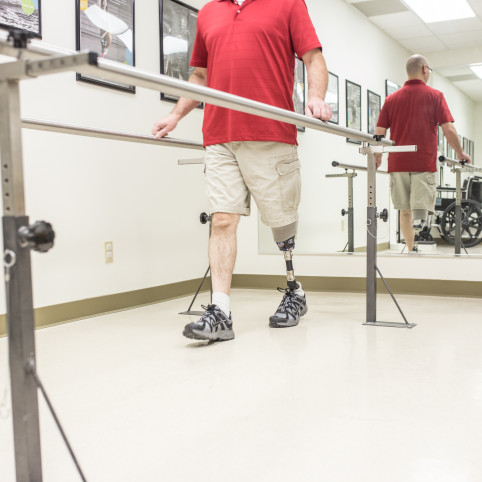Name: PAN
Tel: +86-13126526612
E-mail: info@medi-rehatek.com
Add: North Yanhe East Road 184,Bicheng Street,Bishan District,Chongqing
whatsapp: 0086-131 2652 6612

A disarticulated hip prosthesis has a high amputation plane and numerous components that must be controlled. Therefore, its function and gait training process is relatively complicated in comparison with other lower limb prostheses. On the basis of the overall functional training process, it can be divided into two major stages: 1) balance training and 2) gait training.
Balance training is mainly used during the time following the preparation of the socket model and the period during which they must wait for the production of the prosthetic. The training method is comprised of three parts:
1) Amputee stands in a load-bearing position with pressure on both knees (amputation side uses the ischia for load-bearing on the cast frame). Ensuring that the pelvis is level and in a status of stable static standing, amputee alternates leaning the trunk forward and backward.
2) Amputee stands only on the healthy limb. Confirming that they can do so in a stable and upright state, amputee can twist the pelvis on a horizontal plane. Amputee shouldn't relax when standing and must observe whether the pelvis is level before a mirror.
3) Amputee is in a load-bearing position on only the amputated limb. They can slightly decrease the height of the cast frame. After flexion of the healthy limb, let the amputated side independently bear the load on the ischium. After ensuring that the amputee can stand stable and upright, make sure that they can alternatively make forwards and backwards stepping movements with the healthy limb.
There is also the balanced training process. This comes after the prosthesis assembly and before the beginning of gait training. This is similar to the training process introduced above, except that the role of the load-bearing platform is replaced by that of a prosthesis.
Gait training is the functional training performed by hip disarticulation amputees after they can balance independently. The training steps are as follows:
1) The center of gravity moves during the support phase: Using the prosthesis as the support leg, alternatively make forwards and backwards stepping movements with the healthy limb. This training can help the prosthesis user master ways of moving their center of gravity during the support phase.
2) The center of gravity moves during the swing phase: Using the healthy limb as the support leg, alternatively make forwards and backwards stepping movements with the healthy limb. Doing this kind of training movement can help the prosthesis user master ways of moving their center of gravity during the swing phase. The stepping movement also lets users master the rhythm of movement control of the prosthesis.
3) Gait coordination training: alternatively make forward stepping movements with the prosthesis and healthy limb in order to achieve a certain degree of coordination.
4) Terrain obstacle training: This includes slopes, stairs and other adaptive training related to common aspects of the settings of daily life.
The above process is divided into two parts: 1) training with or 2) without bars. Training with bars refers to training using a handheld balance bar or another auxiliary tool, while training without bars refers to training without relying on a handheld balance bar or another auxiliary tool.
MEDI GLOBAL ASSISTIVE DEVICE CO., LTD is a world leader in the development, design, manufacture and distribution of orthosis,prosthesis, diabetic shoes, compression garments,wheelchairs and so on.
Our website: http://www.medi-rehatek.com
Article Source: http://EzineArticles.com/9727119







 Lower Limb Prostheses
Lower Limb Prostheses






